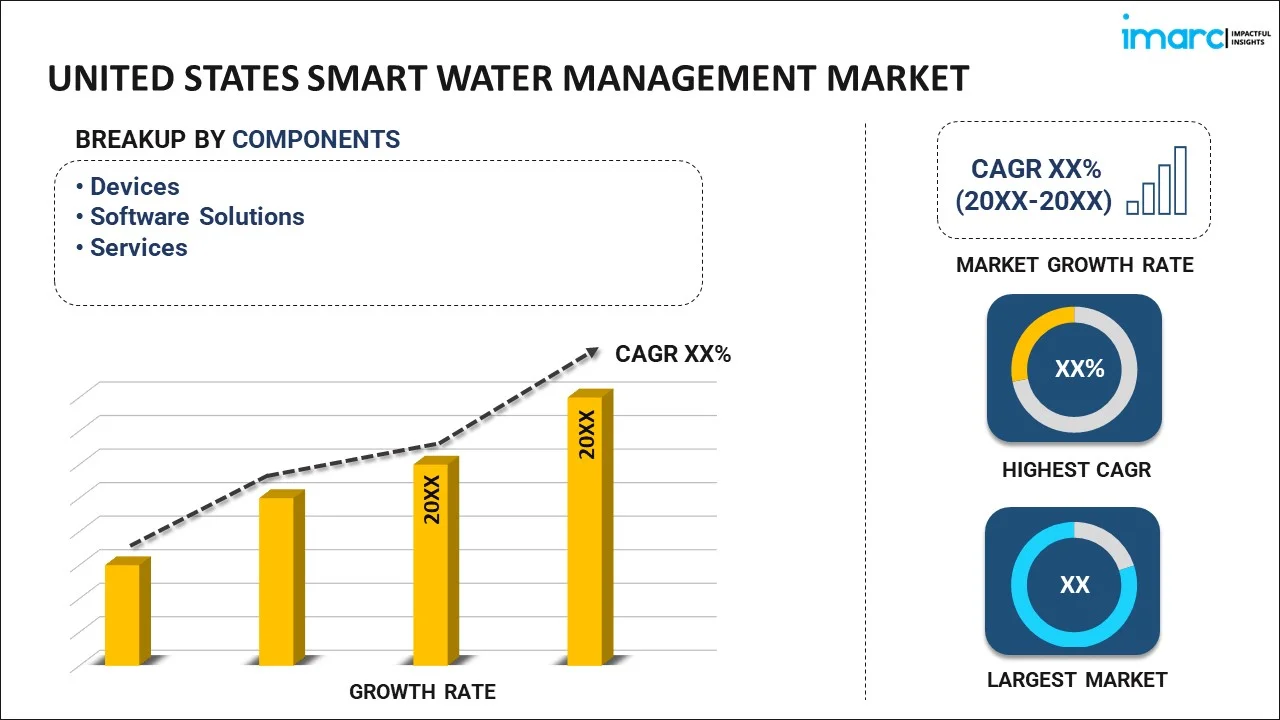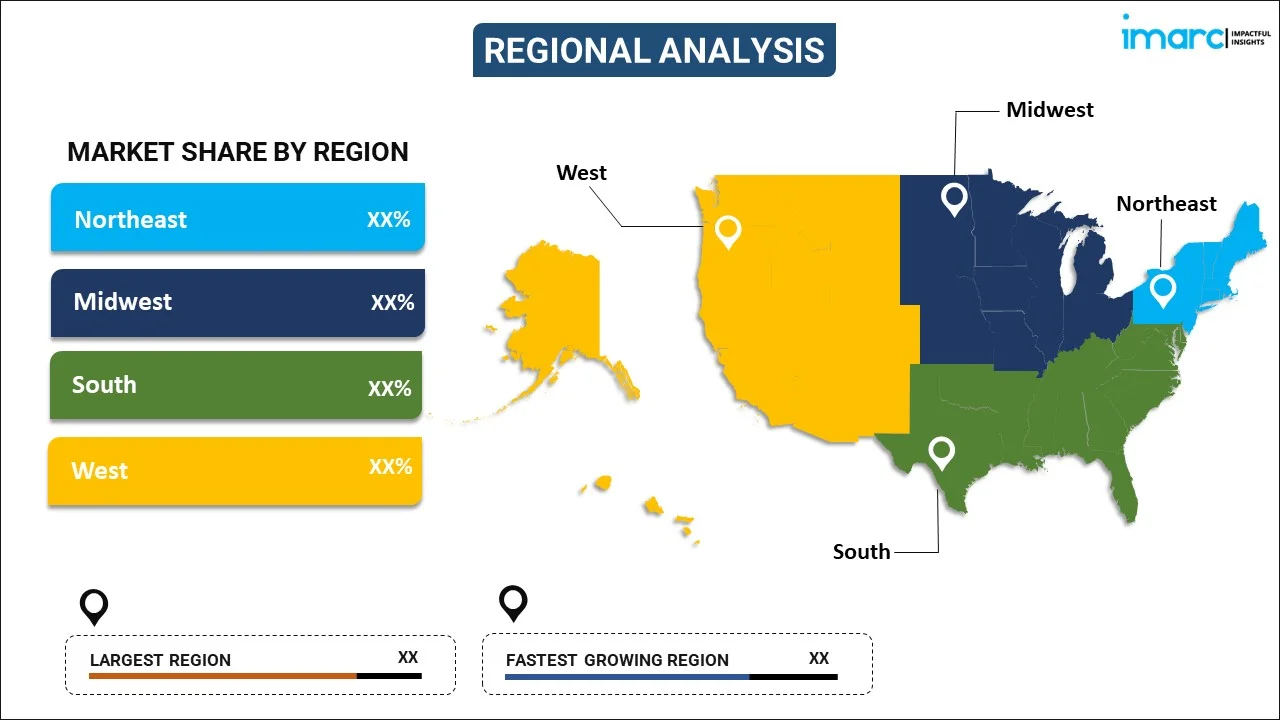
United States Smart Water Management Market Report by Component (Devices, Software Solutions, Services), Application (Residential, Commercial and Industrial), and Region 2025-2033
Market Overview:
United States smart water management market size reached USD 4,837.5 Million in 2024. Looking forward, IMARC Group expects the market to reach USD 12,707.5 Million by 2033, exhibiting a growth rate (CAGR) of 11.33% during 2025-2033. The increasing demand for sensor technologies and data analytics, which enable real-time monitoring, data analysis, and the automation of water distribution systems, improving overall efficiency, is driving the market.
|
Report Attribute
|
Key Statistics
|
|---|---|
|
Base Year
|
2024
|
|
Forecast Years
|
2025-2033
|
|
Historical Years
|
2019-2024
|
| Market Size in 2024 | USD 4,837.5 Million |
| Market Forecast in 2033 | USD 12,707.5 Million |
| Market Growth Rate 2025-2033 | 11.33% |
United States Smart Water Management Market Insights:
- Major Market Drivers: Growing fears of water scarcity and old infrastructure are fueling demand for smart water solutions in the United States, as utilities look to boost efficiency, minimize water loss, and achieve regulatory sustainability goals through smarter monitoring systems.
- Key Market Trends: The convergence of Internet of Things (IoT) real-time analytics, and artificial intelligence (AI) based decision-making is revolutionizing U.S. water utilities by making predictive maintenance, optimized resource utilization, and scalable infrastructure upgrades for smart cities and decentralized water infrastructure possible.
- Competitive Landscape: The United States smart water management market share is dominated by a combination of legacy technology integrators and new innovators, providing scalable solutions for metering, leak detection, and analytics all toward data-driven, customer-centric utility transformation.
- Challenges and Opportunities: Challenges are cybersecurity threats, interoperability concerns, and high upfront cost of deployment, while opportunities are federal investment in infrastructure, initiatives toward climate resilience, and increasing use of data-driven systems within urban as well as rural utility grids.
United States Smart Water Management Market Trends:
Digital Metering and Real-Time Monitoring of Water Usage
The smart water management market in the United States is increasingly determined by integration of digital metering systems that provide real-time data on water usage trends. Advanced meter infrastructure (AMI) facilitates remote, automated measurement of consumption data, enabling utilities to detect leaks or aberrant flow rates. It provides a real-time feedback loop for demand forecasting, system optimization, and increased consumer participation in conservation activities. The transition from analog meters to digital smart meters provides accurate billing and detection of non-revenue water, greatly enhancing operational efficiency. In cities, the digital water meters are also being connected with cloud-based and mobile platforms for aggregation of centralized data as well as analytics. As per the sources, in March 2025, LeakZon raised $5 million in Series A to expand smart water management in the United States, improving cloud-based solutions with regard to integrated, cost-effective water strategies. Moreover, such transparency not only helps in regulatory compliance but also encourages water use sustainability. Consequently, real-time monitoring is the key building block for widespread adoption and efficiency enhancement in the United States smart water management market analysis framework.
IoT and Sensor-Based Infrastructure integration
Among the most revolutionary United States Smart Water Management Market Trends is the integration of IoT-based devices and sensor networks over water treatment and distribution infrastructure. These sensors offer advanced water quality, pressure, temperature, and flow data in real-time, allowing asset management to be proactive. Utilities are able to detect potential threats like pipe breaks, contamination incidents, or equipment failures before they become full-scale issues. This proactive method assists in lengthening the lifespan of the critical infrastructure and lessening maintenance expenses. The collected data is frequently inputted into centralized systems where the machine learning algorithms can suggest predictive maintenance operations or operational optimizations. Moreover, the use of smart sensors aids the automated control systems that respond dynamically based on environmental conditions to provide optimal performance for treatment plants and distribution networks. This degree of automation and responsiveness is instrumental to United States smart water management market growth and ongoing water sustainability efforts.
Adoption of Advanced Data Analytics for Water Optimization
United States Smart Water Management Market Share is being determined by increasing utilization of big data analytics and artificial intelligence to optimize the performance of water systems. With high amounts of data being created through smart meters, sensors, and SCADA, the utilities are now able to do predictive analysis, model demand situations, and optimize distribution systems. These technologies aid in reducing energy consumption during pumping, predicting drought effects, and enhancing emergency preparedness planning. Insights based on data also enhance customer segmentation and interaction through understanding usage patterns and fostering customized conservation programs. In addition, analytics promote transparency for stakeholders, such as municipal governments and environmental organizations, through accurate performance metrics and sustainability indicators. This focus on data-driven decision-making is a major development in United States smart water management market trends, leading to increased efficiency, reduced costs of operations, and improved resource stewardship in public and private water systems.
United States Smart Water Management Market Segmentation:
IMARC Group provides an analysis of the key trends in each segment of the market, along with forecasts at the country level for 2025-2033. Our report has categorized the market based on component and application.
Component Insights:

To get more information on this market, Request Sample
- Devices
- Advanced Water Meters
- Meter Read Technology
- Software Solutions
- Asset Management
- Distribution Network Monitoring
- Supervisory Control and Data Acquisition (SCADA)
- Meter Data Management (MDM)
- Advance Analytics
- Others
- Services
- Managed Services
- Professional Services
The report has provided a detailed breakup and analysis of the market based on the component. This includes devices (advanced water meters and meter read technology), software solutions (asset management, distribution network monitoring, supervisory control and data acquisition (SCADA), meter data management (MDM), advance analytics, and others), and services (managed services and professional services).
Application Insights:
- Residential
- Commercial and Industrial
A detailed breakup and analysis of the market based on the application have also been provided in the report. This includes the residential and commercial and industrial.
Regional Insights:

- Northeast
- Midwest
- South
- West
The report has also provided a comprehensive analysis of all the major regional markets, which include the Northeast, Midwest, South, and West.
Competitive Landscape:
The market research report has also provided a comprehensive analysis of the competitive landscape in the market. Competitive analysis such as market structure, key player positioning, top winning strategies, competitive dashboard, and company evaluation quadrant has been covered in the report. Also, detailed profiles of all major companies have been provided.
Latest News and Developments:
- In July 2025, Grundfos launched Connect Sewer Insights in the US, a next-generation digital wastewater monitoring solution. With radar sensing and AI-based analytics, the platform enables utilities to maximize inflow and infiltration detection, minimize overflows, and enhance operational productivity in the face of increasing climate and infrastructure threats.
- In September 2024, Metron announced at the WaterPro Conference 2024 in Savannah, Georgia, the introduction of two new innovative products. The cutting-edge solutions, as part of its data-first approach, are designed to improve leak detection, optimize water consumption, and enable sustainable water management for U.S. utilities, developers, and property owners.
United States Smart Water Management Market Report Coverage:
| Report Features | Details |
|---|---|
| Base Year of the Analysis | 2024 |
| Historical Period | 2019-2024 |
| Forecast Period | 2025-2033 |
| Units | Million USD |
| Scope of the Report | Exploration of Historical Trends and Market Outlook, Industry Catalysts and Challenges, Segment-Wise Historical and Future Market Assessment:
|
| Components Covered |
|
| Applications Covered | Residential, Commercial and Industrial |
| Regions Covered | Northeast, Midwest, South, West |
| Customization Scope | 10% Free Customization |
| Post-Sale Analyst Support | 10-12 Weeks |
| Delivery Format | PDF and Excel through Email (We can also provide the editable version of the report in PPT/Word format on special request) |
Key Benefits for Stakeholders:
- IMARC’s industry report offers a comprehensive quantitative analysis of various market segments, historical and current market trends, market forecasts, and dynamics of the United States smart water management market from 2019-2033.
- The research report provides the latest information on the market drivers, challenges, and opportunities in the United States smart water management market.
- Porter's five forces analysis assist stakeholders in assessing the impact of new entrants, competitive rivalry, supplier power, buyer power, and the threat of substitution. It helps stakeholders to analyze the level of competition within the United States smart water management industry and its attractiveness.
- Competitive landscape allows stakeholders to understand their competitive environment and provides an insight into the current positions of key players in the market.
Key Questions Answered in This Report
The smart water management market in the United States was valued at USD 4,837.5 Million in 2024.
The United States smart water management market is projected to exhibit a (CAGR) of 11.33% during 2025-2033, reaching a value of USD 12,707.5 Million by 2033.
Major drivers for the market are escalating water scarcity, old infrastructure, regulation requirements for water conservation, and escalating demand for real-time monitoring and leak detection. Advances in technology like IoT-based sensors, data analytics, and AI-based platforms are also fueling adoption, allowing utilities to improve operational efficiency, minimize non-revenue water, and support sustainable resource utilization.
Need more help?
- Speak to our experienced analysts for insights on the current market scenarios.
- Include additional segments and countries to customize the report as per your requirement.
- Gain an unparalleled competitive advantage in your domain by understanding how to utilize the report and positively impacting your operations and revenue.
- For further assistance, please connect with our analysts.
 Request Customization
Request Customization
 Speak to an Analyst
Speak to an Analyst
 Request Brochure
Request Brochure
 Inquire Before Buying
Inquire Before Buying




.webp)




.webp)












